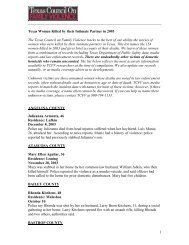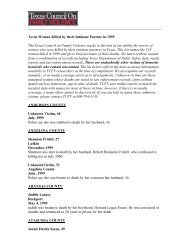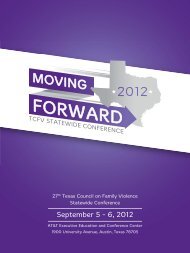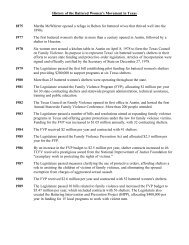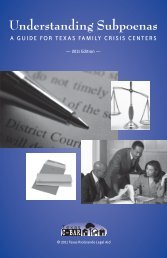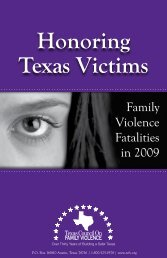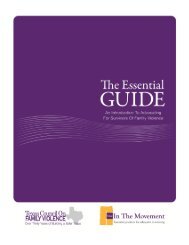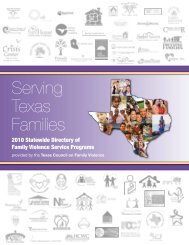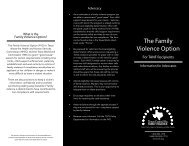Homeward Bound - Texas Council on Family Violence
Homeward Bound - Texas Council on Family Violence
Homeward Bound - Texas Council on Family Violence
- No tags were found...
You also want an ePaper? Increase the reach of your titles
YUMPU automatically turns print PDFs into web optimized ePapers that Google loves.
<str<strong>on</strong>g>Homeward</str<strong>on</strong>g> <str<strong>on</strong>g>Bound</str<strong>on</strong>g>Federal Housing Law and the Rights ofVictims of Domestic <strong>Violence</strong>, Dating<strong>Violence</strong>, and StalkingRamey KoEqual Justice Works Fellow<str<strong>on</strong>g>Texas</str<strong>on</strong>g> RioGrande Legal Aid
Which federal housing laws addressdomestic violence?• <strong>Violence</strong> Against Women and JusticeDepartment Reauthorizati<strong>on</strong> Act of 2005(Pub. L. 109-162)• Fair Housing Act (Title VIII of the CivilRights Acts of 1968)
What housing problems do victimsface?• Evicti<strong>on</strong>• Loss (terminati<strong>on</strong>) of housing benefits• Denial of admissi<strong>on</strong> to housing (private andsubsidized)• Denial of housing benefits• Discriminatory rules and policies
Why are DV victims evicted or deniedhousing and housing benefits?• Violent or criminal activity by abuser (―<strong>on</strong>e strike‖policy)• Police or security being called• ―Nuisance‖ or ―disturbance‖ of noise or effects ofviolence• Property damage because of abuse• Unauthorized ―occupant‖ or ―guest‖• Status: stereotypes and mispercepti<strong>on</strong>s about victims• Criminal history (self-defense or mutual arrest)• Financial abuse of victim: poor or no credit history;poor or no rental history (prior evicti<strong>on</strong>s,terminati<strong>on</strong>s)
What areas does VAWA cover?• Admissi<strong>on</strong>s• Evicti<strong>on</strong>s (Public Housing)• Terminati<strong>on</strong> of Assistance (Secti<strong>on</strong> 8Housing Assistance Vouchers)• Portability• C<strong>on</strong>fidentiality
What is “domestic violence”?• VAWA uses the definiti<strong>on</strong> given in 42 U.S.C. §13925(a)(6). 42 U.S.C. §§ 1437d(u)(3)(A); 1437f(f)(8).• ―Domestic violence‖ includes fel<strong>on</strong>y or misdemeanorcrimes of violence committed by:– A current or former spouse of the victim– A pers<strong>on</strong> with whom the victim shares a child in comm<strong>on</strong>– A pers<strong>on</strong> who is cohabitating with or has cohabitated withthe victim as a spouse– A pers<strong>on</strong> similarly situated to a spouse of the victim underthe domestic or family violence laws of the jurisdicti<strong>on</strong>receiving grant m<strong>on</strong>ies– Any other pers<strong>on</strong> against an adult or youth victim who isprotected from that pers<strong>on</strong>'s acts under the domestic orfamily violence laws of the jurisdicti<strong>on</strong>.
What is “dating violence”?• VAWA uses the definiti<strong>on</strong> given in 42 U.S.C. § 13925(a)(8).42 U.S.C. §§ 1437d(u)(3)(B); 1437f(f)(9).• The term "dating violence" means violence committed bya pers<strong>on</strong> —– who is or has been in a social relati<strong>on</strong>ship of aromantic or intimate nature with the victim; and– where the existence of such a relati<strong>on</strong>ship shall bedetermined based <strong>on</strong> a c<strong>on</strong>siderati<strong>on</strong> of the followingfactors:• The length of the relati<strong>on</strong>ship.• The type of relati<strong>on</strong>ship.• The frequency of interacti<strong>on</strong> between the pers<strong>on</strong>sinvolved in the relati<strong>on</strong>ship.
How does VAWA protect DV victimsfrom evicti<strong>on</strong> and/or terminati<strong>on</strong>?• VAWA essentially creates an excepti<strong>on</strong> to the federal ―<strong>on</strong>estrike‖ policy for victims of domestic violence.• Criminal activity against a tenant or immediate family memberby a household member, guest, or ―other pers<strong>on</strong> under thetenant’s c<strong>on</strong>trol‖ ―directly relating to‖ domestic violence, datingviolence, or stalking does not c<strong>on</strong>stitute grounds forterminati<strong>on</strong> of tenancy (evicti<strong>on</strong>) or terminati<strong>on</strong> of Secti<strong>on</strong> 8voucher.• 42 U.S.C. §§ 1437d(l)(6)(A)(public housing); 1437f(c)(9)(C)(i),(d)(1)(B)(iii), (o)(7)(D)(i)(Secti<strong>on</strong> 8).• An incident of actual or threatened domestic violence, datingviolence, or stalking does not qualify as ―serious or repeatedlease violati<strong>on</strong>‖ or ―good cause‖ for terminating assistance,tenancy, or occupancy rights of victim.• 42 U.S.C. §§ 1437d(l)(5)(public housing); 1437f(c)(9)(B),(d)(1)(B)(ii), (o)(7)(C)(Secti<strong>on</strong> 8).
How does VAWA protect DV victimsfrom being denied admissi<strong>on</strong> orassistance?• An individual’s status as a victim of domesticviolence, dating violence, or stalking is not anappropriate basis for denial of admissi<strong>on</strong> ordenial of housing assistance.• 42 U.S.C. §§ 1437d(c)(3); 1437f(c)(9)(A);1437f(d)(1)(A); 1437f(o)(B) (2006).
Can a victim still get rid of an abuserif they share housing or a voucher?• A landlord may bifurcate a lease to evict, remove, orterminate occupancy rights of a tenant or householdmember who commits domestic violence whilepreserving the tenancy or occupancy rights of thevictim.• A PHA may also terminate assistance to the abuserwhile preserving assistance to the victim.• 42 U.S.C. §§ 1437d(l)(6)(B)(public housing);1437f(c)(9)(C)(iv), (d)(1)(B)(iii)(II),(o)(7)(D)(ii)(Secti<strong>on</strong> 8).
What other rights does VAWA providefor DV victims?• Portability Change: A family with a Secti<strong>on</strong> 8voucher may move to another jurisdicti<strong>on</strong> if thefamily has complied with all other obligati<strong>on</strong>s of theprogram and is moving to protect health or safety ofan individual who is or has been the victim ofdomestic violence, dating violence, or stalking – evenif moving would otherwise be a lease violati<strong>on</strong>.• 42 U.S.C. § 1437f(r)(5).• A PHA may still ask for documentati<strong>on</strong> from thefamily regarding the family’s desire to move to a newjurisdicti<strong>on</strong> because of domestic violence, datingviolence, or stalking.• 42 U.S.C. § 1437f(ee).
What are the limits to the protecti<strong>on</strong>sVAWA provides to DV victims?• Does not apply to lease violati<strong>on</strong>s unrelated todomestic violence, dating violence, or stalking.– BUT, victims cannot be held to a higher standard than othertenants.– 42 U.S.C. §§ 1437d(l)(6)(D)(public housing);1437f(c)(9)(C)(iv), (d)(1)(B)(iii)(IV), (o)(7)(D)(iv)(Secti<strong>on</strong>8).• Does not apply if landlord can show that allowingvictim to remain would be ―actual and imminentthreat to other tenants or those employed at orproviding service to the property.‖• 42 U.S.C. §§ 1437d(l)(6)(E)(public housing);1437f(c)(9)(C)(v), (d)(1)(B)(iii)(V),(o)(7)(D)(v)(Secti<strong>on</strong> 8).
What about housing protecti<strong>on</strong>s forDV victims under state or local law?• When a federal, state, or local law offersgreater protecti<strong>on</strong> for victims, the morefavorable law governs.• 42 U.S.C. §§ 1437(d)(l)(6)(F)(publichousing); 1437f(c)(9)(C)(vi),(d)(1)(B)(iii)(VI), (o)(7)(D)(vi)(Secti<strong>on</strong> 8).
How does a resident prove she is avictim of domestic violence?• PHA or Secti<strong>on</strong> 8 landlord may ask for documentati<strong>on</strong> thattenant is or has been a victim. Approved documentati<strong>on</strong>:– Police or court record (including DV or family court orders)– Statement signed by certain professi<strong>on</strong>als– HUD-approved certificati<strong>on</strong> form – Form HUD-50066 (PublicHousing and Voucher Program) and HUD-90066 (Project-basedSecti<strong>on</strong> 8)• Victim has at least 14 business days to provide documentati<strong>on</strong>after receiving written request.• PHA or Secti<strong>on</strong> 8 landlord is not required to request specifictype of documentati<strong>on</strong> – may accept various forms, includingvictim’s own statement.• PHAs and Secti<strong>on</strong> 8 landlords should h<strong>on</strong>or civil protecti<strong>on</strong>orders and other orders from DV and family court judges thataddress rights of access to or c<strong>on</strong>trol of the property.• 42 U.S.C. §§ 1437d(u)(public housing); 1437f(ee)(Secti<strong>on</strong> 8).
How does VAWA protect a victim’sc<strong>on</strong>fidentiality?• If victim provides documentati<strong>on</strong>, PHA or Secti<strong>on</strong> 8landlord must keep the informati<strong>on</strong> c<strong>on</strong>fidential,including the individual’s status as a victim.• PHA or Secti<strong>on</strong> 8 landlord may not enter theinformati<strong>on</strong> into any shared database or provide it toany related entity.• This is a change for the Secti<strong>on</strong> 8 voucher program.• Additi<strong>on</strong>al disclosure clarificati<strong>on</strong>s apply.• Where state or federal law is more favorable tovictim than VAWA, more favorable law governs.• See 42 U.S.C. §§ 1437d(u)(2)(A); 1437f(ee)(2)(A).
How does VAWA protect a victim’sc<strong>on</strong>fidentiality? (c<strong>on</strong>t’d)• Local victim services providers who are granteesunder federal HUD homelessness assistanceprograms must not enter pers<strong>on</strong>ally-identifyinginformati<strong>on</strong> about victims of VAW into any shareddatabase, such as the Homeless ManagementInformati<strong>on</strong> System (HMIS)• Encoding or scrambling pers<strong>on</strong>ally identifyinginformati<strong>on</strong> does not make the informati<strong>on</strong> subjectto disclosure to HUD
How does VAWA protect a victim’sc<strong>on</strong>fidentiality? (c<strong>on</strong>t’d)• Only a new issue for federal HUD homelessnessassistance grantees who otherwise would be subject toHUD’s HMIS reporting (―C<strong>on</strong>tinuum of Care‖ grantees).– Nothing new, for example, for HHS grantees receivingFVPSA funds, or for exclusively state or local funds.– Local programs should determine where they get funds.• Also c<strong>on</strong>sider state and local privacy laws• Nati<strong>on</strong>al Network to End Domestic <strong>Violence</strong>– http://www.nnedv.org/pdf/VAWAC<strong>on</strong>fidentiality.pdf• Info from HUD:– http://www.hud.gov/homeless/index.cfm• 42 U.S.C. § 11383(a)(8) (federal statute).
What notice of victims’ rights underVAWA must PHAs give?• PHAs must give notice of updated resident rights inadmissi<strong>on</strong>s, evicti<strong>on</strong>s, and terminati<strong>on</strong>s of subsidy,c<strong>on</strong>fidentiality, and, for voucher participants, newexpedited portability rules to:– Public housing residents. 42 U.S.C. § 1437d(u)(2)(B).– Voucher and project-based Secti<strong>on</strong> 8 residents. 42 U.S.C. §1437f(ee)(2)(B).– Secti<strong>on</strong> 8 owners and managers. 42 U.S.C. §1437f(ee)(2)(B).• Sample notice forms are available from HUD.• Notices may be addressed in the PHA Plan…
What other new requirements doesVAWA impose <strong>on</strong> PHAs?• PHA Five Year Plan must include statement of goalsthat will enable PHA to serve needs of child andadult victims of all VAW, including sexual assault.• PHA Plan (Annual Plan) must c<strong>on</strong>sider and describe:– Any services provided to victims of VAW– Any activities to prevent VAW or enhance victim safety– Any activities that help victims obtain or maintain housing• 42 U.S.C. §§ 1437c-1 (a)(2), (d)(13).• PHA C<strong>on</strong>solidated Plan (―C<strong>on</strong> Plan‖) must nowaddress housing needs of victims of all VAW,including sexual assault.• 42 U.S.C. § 12705(b)(1).
What issues must PHAs address intheir Annual Plan?• Activities, services, or programs described in PHA Plan may beprovided– Directly by PHA, or– In partnership with other service providers• Opportunity for collaborati<strong>on</strong>• Activities, services, or programs offered to prevent VAW mayinclude, for example– Training for staff– Workshops for residents, for children of residents– Extra security– Other
What issues must PHAs address intheir Annual Plan? (c<strong>on</strong>t’d)• Activities, services, or programs offered that helpvictims of VAW obtain housing, for example:– Admissi<strong>on</strong>s Policies: Preferences• Already encouraged for victims of domestic violence. 24CFR 960.208(b)(4).• C<strong>on</strong>sider reviewing other preferences to determine ifthey present barriers for victims of VAW, e.g. ―working‖preference.– C<strong>on</strong>sider reviewing other admissi<strong>on</strong>s policies thatpresent barriers.• For example, poor credit or work history, poor landlordreferences or rental history, history of disturbances atprior residences, criminal record related to VAW, etc.
What issues must PHAs address intheir Annual Plan? (c<strong>on</strong>t’d)• Activities, services, or programs offered that helpvictims of VAW maintain housing, for example:– Rules regarding evicti<strong>on</strong> and leases, including bifurcati<strong>on</strong>,family break-up, divisi<strong>on</strong> of assistance– Policies regarding terminati<strong>on</strong> of voucher subsidy– Rules regarding terminati<strong>on</strong> of lease by voucherparticipants and portability policies– Certificati<strong>on</strong> that individual is a victim of VAW• Will PHA allow victim to self-certify? Under whatcircumstances?• Will PHA allow victim more than 14 days to obtaincertificati<strong>on</strong>; if so, under what circumstances?
Where can I find more informati<strong>on</strong> <strong>on</strong>PHA Plans?• 42 U.S.C. § 1437c–1 (federal statute).• 24 C.F.R. Part 903 (federal regulati<strong>on</strong>s).• Federal guidance from HUD:– Public Housing Agency [PHA] Plan Desk Guide athttp://www.hud.gov/offices/pih/pha/index.cfm– HUD 50075, PHA Plans Template athttp://www.hud.gov/offices/pih/pha/index.cfm• ―Resident’s Guide to the New Public Housing Plans‖– http://www.communitychange.org/• Nati<strong>on</strong>al Housing Law Project: http://www.nhlp.org
What issues must PHAs address intheir C<strong>on</strong>solidated Plan (“C<strong>on</strong> Plan”)?• C<strong>on</strong> Plan must address housing needs of all victims of VAW,including sexual assault. 42 U.S.C. § 12705(b)(1).• C<strong>on</strong> Plan includes:– Identificati<strong>on</strong> of needs• PHAs can obtain data <strong>on</strong> VAW and housing needs from stateor local welfare, public health, homelessness, justice agencies;also 911, law enforcement, domestic violence courts.– L<strong>on</strong>g term strategies– Setting priorities• Important issue because of inadequate funding.• 24 CFR § 91.215.
Where can I find more informati<strong>on</strong> <strong>on</strong>C<strong>on</strong> Plans?• 42 U.S.C. § 12705 (federal statute).• 24 C.F.R. Part 91, as amended by 71 Fed. Reg. 6950(Feb. 9, 2006) (federal regulati<strong>on</strong>s).• Federal guidance from HUD– http://www.hud.gov/offices/cpd/about/c<strong>on</strong>plan/• ―HUD’s C<strong>on</strong>solidated Plan: An Acti<strong>on</strong> Plan forInvolving Low Income Communities‖– http://www.communitychange.org/
Does VAWA create any pilot programsto address domestic violence?• Grants to Combat <strong>Violence</strong> Against Women in Public andAssisted Housing– Public and assisted housing agency grantees will attest to bestpractices and n<strong>on</strong>-discriminati<strong>on</strong> in admissi<strong>on</strong>s and occupancypolicies.– To be administered by Office <strong>on</strong> <strong>Violence</strong> Against Women, USDOJ,c<strong>on</strong>sulting with HUD and HHS.– Authorized at $10 milli<strong>on</strong> annually; n<strong>on</strong>e yet for FY 2007.• Collaborative Grants to Increase the L<strong>on</strong>g-Term Stability ofVictims– Housing, homelessness, and victim service providers willcollaborate to develop l<strong>on</strong>g-term, affordable housing for victims ofVAW who are homeless or at risk for it.– To be administered by HHS, c<strong>on</strong>sulting with HUD.– Authorized at $10 milli<strong>on</strong> annually; n<strong>on</strong>e yet for FY 2007.
What other housing issues are notexplicitly addressed by VAWA?• Further investigati<strong>on</strong> of negative or potentiallydisqualifying informati<strong>on</strong> to determine if they are thec<strong>on</strong>sequence of domestic violence• Emergency transfers within a jurisdicti<strong>on</strong>– Expedited approval and inspecti<strong>on</strong>– No need for a rescissi<strong>on</strong> agreement (mirror crossjurisdicti<strong>on</strong>protecti<strong>on</strong>s)– Interacti<strong>on</strong> with <str<strong>on</strong>g>Texas</str<strong>on</strong>g> law• Emergency transfers within public housing• Emergency transfers from Secti<strong>on</strong> 8 project-basedunits
What other housing issues are notexplicitly addressed by VAWA? (c<strong>on</strong>t’d)• Charging costs for damages to abuser, not victim• Procedures for changing locks; for trespass• Serving immigrant victims and families; providing referrals• Preferences <strong>on</strong> waiting lists• Divisi<strong>on</strong> of assistance following an incident– ―<strong>Family</strong> break-up‖ policies in Secti<strong>on</strong> 8 voucher program• Abuser revisits or stalks victim– Lack of enforcement of court DV protecti<strong>on</strong> orders by police– Abuse and violence affects victim’s ―c<strong>on</strong>sent‖– Landlords and PHAs may want to intervene <strong>on</strong> behalf of victim• Lack of training <strong>on</strong> VAW– Staff, managers, security, police can misunderstand facts• Need for collaborati<strong>on</strong> with domestic violence experts
What other federal housing laws canprotect victims of domestic violence?• Fair Housing Act (―FHA‖)– Prohibits landlord or homeowner from discriminatingagainst a tenant or a purchaser because of sex.– This federal law applies to most private landlords (as well asto public housing and Secti<strong>on</strong> 8); also to private ownersselling real estate .– Only a few excepti<strong>on</strong>s: (1) single-family houses where ownerdoesn’t own more than three such houses, and (2) owneroccupieddwellings c<strong>on</strong>taining four or fewer units.• Treating an individual differently from other tenantsbecause she is a victim of domestic violence mayviolate the FHA.
How does the Fair Housing Actprotect victims of domestic violence?• ―Disparate impact‖ – has been used tosuccessfully challenge neutral policy that hasthe effect of falling more harshly <strong>on</strong> women.See Alvera v. Creekside VillageApartments (HUD ALJ 10-99-0538-8) 2001(no-violence policy used to evict victim);Bouley v. Young-Sabourin, 2005 WL 950632(D. Vt. Mar. 10, 2005).• Disparate impact can be shown usingstatistics.
How does the Fair Housing Act protectvictims of domestic violence? (c<strong>on</strong>t’d)• ―Disparate treatment‖ – a property owner actuallyintends to discriminate against some<strong>on</strong>e based <strong>on</strong>their sex.• Taking acti<strong>on</strong>s based <strong>on</strong> an individual because ofsex-based stereotypes can state a claim. See, e.g.,Bouley (noise, damage to the apartment used asjustificati<strong>on</strong> to evict – successfully challenged in VTfederal district court <strong>on</strong> sex stereotyping anddisparate impact grounds).
Additi<strong>on</strong>al Resources• Federal statutes (see above)• Federal regulati<strong>on</strong>s (see above)• HUD VAWA implementing regulati<strong>on</strong>s (TBA – 2007?)• HUD Notice PIH 2006-23 (June 23, 2006)– Announces VAWA changes in Public and Secti<strong>on</strong> 8 housing– Available at http://www.hudclips.org• HUD Public Housing Occupancy Guidebook, Ch. 19 (2003)• Nati<strong>on</strong>al Law Center <strong>on</strong> Homelessness and Poverty,http://www.nlchp.org/FA_DV/index.cfm– More info <strong>on</strong> new VAWA housing protecti<strong>on</strong>s– Report with CLPHA <strong>on</strong> some local PHA practices• <str<strong>on</strong>g>Texas</str<strong>on</strong>g> RioGrande Legal Aid Housing and Domestic <strong>Violence</strong>Project– Ramey Ko, Project Fellow, rko@trla.org
Acknowledgments• This presentati<strong>on</strong> was prepared usingmaterials created by:– Naomi Stern, Former Staff Attorney, Domestic<strong>Violence</strong> Program, Nati<strong>on</strong>al Law Center <strong>on</strong>Homelessness & Poverty– Deborah Widiss, Attorney, Legal Momentum– Barbara Zimbel, Attorney, Greater Bost<strong>on</strong> LegalServices



